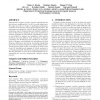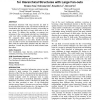2021 search results - page 69 / 405 » Energy-aware user interfaces: an evaluation of user acceptan... |
EXPCS
2007
15 years 3 months ago
2007
Experimental computer systems research typically ignores the end-user, modeling him, if at all, in overly simple ways. We argue that this (1) results in inadequate performance eva...
CHI
2010
ACM
14 years 10 months ago
2010
ACM
Hierarchical structures with large fan-outs are hard to browse and understand. In the conventional node-link tree visualization, the screen quickly becomes overcrowded as users op...
ICMCS
1999
IEEE
15 years 4 months ago
1999
IEEE
This work presents a usability evaluation performed during the field-test of a speech based data-entry system. The application domain is the data-entry of personnel absence record...
BCSHCI
2007
15 years 1 months ago
2007
Personalization of a self-services kiosk or ATM may provide the user with an efficient means of obtaining new appropriate services with the degree of immediate gratification consu...
UMUAI
2008
14 years 11 months ago
2008
This paper aims to demonstrate that the principles of adaptation and user modeling, especially social annotation, can be integrated fruitfully with those of the Web 2.0 paradigm a...


